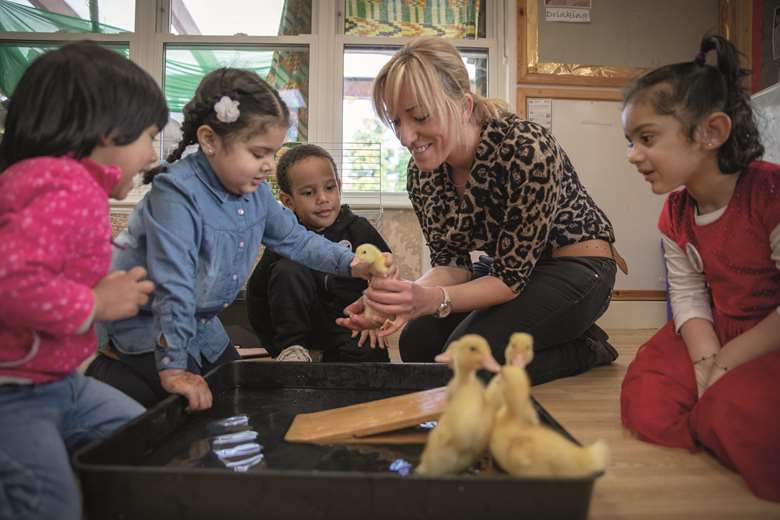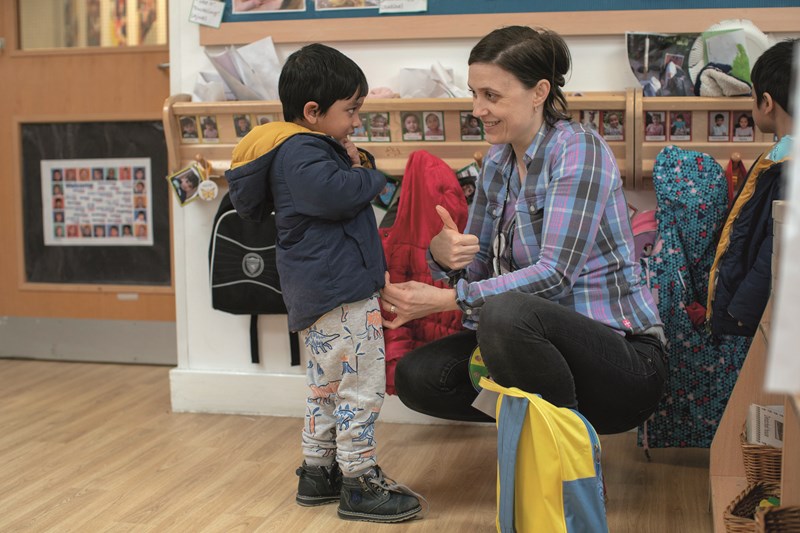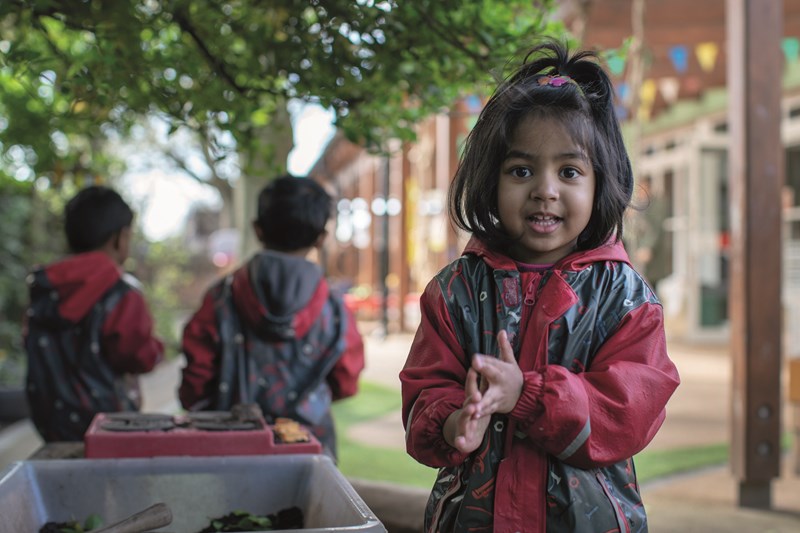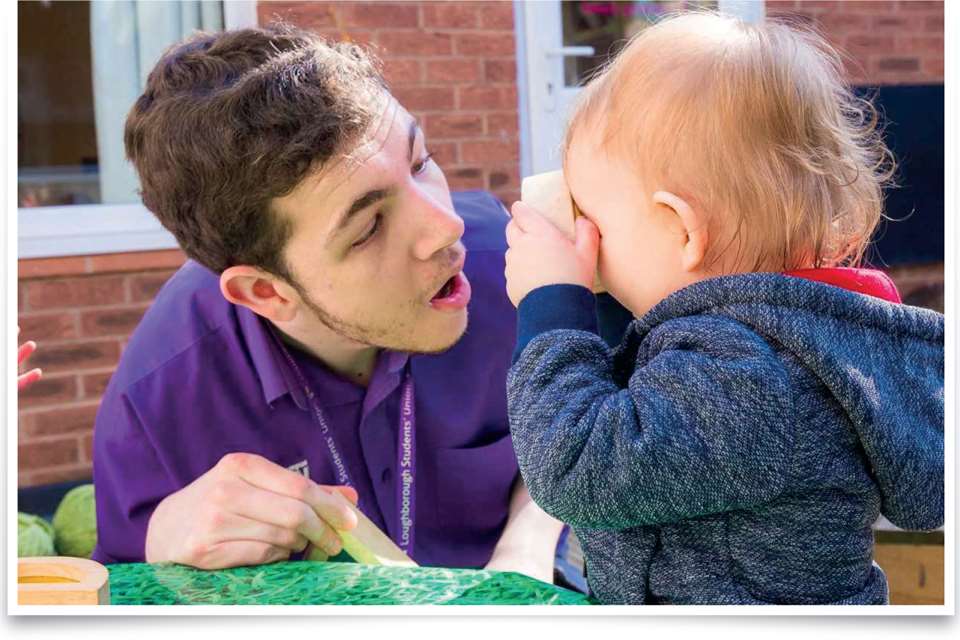Building Your Curriculum: Communication & Language - Starting points
Dr Julian Grenier
Tuesday, April 7, 2020
What are the barriers that some children face in becoming good communicators, and how can early years settings support them? Dr Julian Grenier reports

In recent years, practitioners in the early years have worked hard to support children’s early communication. This is important work. One of the most powerful things we can do to help a child’s development is help them to become a better communicator. Communication underpins children’s thinking and learning. Being a good communicator enables you to make friends and play with others.
Despite all this positive work, we need to do more in the early years. If we use the Early Learning Goals as our measure, we can see that around 86 per cent of children achieve the goals in communication.
Eighty-six per cent is a high proportion. But it is important to remember that around 14 per cent of children leave the EYFS without being able to communicate as well as we might hope. That is about 90,000 children every year – a huge number of young children.
We also know that better-off children are, in general, better communicators. There is gap of around ten percentage points between disadvantaged children and all others in the area of communication. The gap overall between disadvantaged children and the rest has been roughly the same for the past six years. That means England is a country where your family income is a strong predictor of how well you will get on in school.
Countries such as Finland and Canada do a much better job at giving every child an equal chance of success, regardless of background. That is why we need to redouble our efforts at all stages in the early years so that we do our best for every child. Part of the rationale behind the revision of Development Matters, which I am leading, is tackling this problematic gap.
The revision of Development Matters will also address the problem we have in the sector of excessive workload. There are many causes of the excessive workload which is causing such difficulties in practitioners’ lives.
We need to work together as a sector to cut out unnecessary paperwork. This will not only reduce the pressure on us all, but also free up more time to spend listening to children and having conversations with them. That is probably one of the most powerful things we can all do to help children become better communicators.
FORMIDABLE CHALLENGES
Growing up in poverty
Before going any further, we should consider some of the formidable challenges which can face us in the early years. It is important to remember that every child and every family is unique. Each child brings something special and important into an early years setting. But overall, children who grow up in poverty and in over-crowded housing are more likely to have difficulties with their early communication. There are probably two main reasons for this.
First, overcrowded housing is noisy. That makes it difficult for a baby to tune into language, or for a toddler to start developing ‘serve and return’ conversations.
Secondly, the adults in the house are likely to be preoccupied with day-to-day survival. Maybe they are worrying about how to provide the next meal, or top up the electricity meter. They might be struggling to organise childcare at short notice, as they have a zero-hours contract. In those circumstances, it can be difficult to find time to enjoy playing and talking with your children.
Disadvantaged twos
That was one of the reasons behind the decision to offer free early education and childcare for all disadvantaged two-year olds. That policy, which began over a decade ago, is beginning to work. After a difficult start, when it looked as if the children gained no benefit from this extra year, the latest evidence from the SEED Project is positive.
It says that, ‘For the 40 per cent most disadvantaged children, starting to use a minimum of ten hours per week formal ECEC no later than age two, combined with a mean use of over 20 hours per week of formal ECEC between age two and the start of school, increases the chances of achieving expected EYFSP levels in school Reception year and improves children’s verbal ability in school year one.’
Less focus on language
Additionally, it seems that we may be seeing a decline in children’s home experiences of talking, singing and learning nursery rhymes. It’s likely that as children’s engagement in playing with phones and tablets rises, the focus on play and talking might be diminishing.
For example, in 2017, Ofcom reported that nearly half of all children aged three to four years use YouTube. More than half are online for eight hours per week.
SUPPORTING FAMILIES
All my experience of working with families tells me that parents want the very best for their children. But some can struggle with the challenges of modern life. Our responses have to be positive, and based on respectful collaborations with parents. We must not sink into a blaming culture, or a culture of low expectations.
Hungry Little Minds
One helpful resource is the Department for Education’s campaign called Hungry Little Minds. This is a useful starting point for discussions with parents. It explains how even small changes to family routines can make a big difference to children’s communication.
EasyPeasy
In Newham, we have also seen very positive results using an app called EasyPeasy. The app sends parents weekly messages with suggested ways of playing with their children. It also sends reminders and encourages parents to communicate with their nursery setting about how they are getting on. In this way, the app supplements the work of professionals on the ground and focuses on the importance of play-based learning.
A GENDER GAP
Research also tells us that, in general, boys receive less support for learning at home than girls. It seems that from an early age, many girls are encouraged to be close to adults, talk with them, and play or take part in collaborative activities. On the other hand, it seems that boys are encouraged to get on with things by themselves in a more independent way.
It is easy to see how girls’ socialisation prepares them well for their early education and care. So, as early years practitioners, we have to work especially hard to encourage boys to communicate as they play. That means encouraging children – boys and girls – to feel confident to take part in all of the different activities on offer.
It also means going to where children are. We need to engage with children’s interests and fascinations as we interact and talk with them in a sensitive way. All too often, if you scan around an early years setting you will see rings of girls around practitioners. The boys will be playing some way off in the distance, without talking much.
PRACTICE CAN MAKE A DIFFERENCE

Babies and toddlers
At every stage within the early years, we need to make communication our top priority. It is well known that babies benefit from ‘tummy time’. But we also need to think about the crucial importance of responding to babies’ communications. We need to tune in and respond to all their gestures and vocalisations, and celebrate all their different achievements.
For toddlers and two-year-olds, adults need to make time for listening and developing conversations. We also need to teach babies, toddlers and young children nursery rhymes and songs. Then they will gradually develop a repertoire of favourites, which they know off by heart.
High-quality interactions
Research findings suggest that prioritising time for talk in small groups can be especially important. It is the quality of that time which matters more than anything. Using picturebooks with no words, adults can encourage children to talk about illustrations and develop their own ideas. It is important for adults to model talk that is speculative and encourages reasoning. Then children will become used to talking about things beyond the here and now.
The Education Endowment Foundation’s guidance report, Preparing for Literacy, shows how open-ended questions help children to develop language for reasoning (see box, below).
Key person role
It is also important to acknowledge many of the challenges of working with two-, three- and four-year-olds. Making time for talk can be challenging in busy, free-flow play environments. This is especially so when the children need a lot of support and care. It is vital that settings have a well-organised key person approach.
Children need a key person who can give them lots of time and emotional support when they settle in, and throughout their whole time. Without this sort of social and emotional support, many children simply will not talk. After all, you are much more likely to talk with someone whom you care about, and who is interested in you.
Care routines, like nappy changing, can easily be times for communication too. You might make up a special song with the child, or talk them through everything you are doing.
Engaging in role play
When children do not have much language, trying to talk with them can be very tiring. That is one reason why enjoyable focal points for conversation are so important. In their pretend play, children will naturally use language with each other. Where children are not engaged in this type of play, practitioners need to consider how they can help them to join in.
It might be helpful to watch some play for a short period of time with the child. You could provide a commentary on what you are seeing. Then you could suggest some possible ways for the child to join in: ‘Maybe there could be a dog in the house… would you like to be the dog?’ We must look out for children who are not talking much and make a special effort to engage them in communication.
Sharing stories
Children in the early years need lots of opportunities to listen to high-quality stories. The practitioners reading those stories need to be enthusiastic. They need to be confident and organised to enhance their storytimes with props, dressing up and anything else that will bring the story to life. Children need these high-quality storytimes at least once a day. They also need time throughout the session to enjoy a wide range of books with adults in pairs or small groups.
An especially powerful approach to using story books with young children is called ‘dialogic reading’. Instead of reading stories to children, this approach involves using the book as a focus for conversation. The children are encouraged to ask questions, and relate what they see or hear to their own experiences. Preparing for Literacy suggests an approach which they call the ‘PEER framework’ (see box, page 20).
Building vocabulary
A recent experience we have had at Sheringham Nursery School, which has prompted a lot of reflection, is focusing on children’s vocabulary. Some children are very chatty, and do not seem to present us with any concerns with respect to their language development. But, when we have looked more closely at their vocabulary, we have found that we need to do more.
‘Tier 2 vocabulary’
The children might use a range of everyday words such as ‘house’, ‘street’, ‘tree’ and ‘car’, and be engaging conversationalists. But there are also words that are used in a range of contexts but are not ‘everyday’ words. This is sometimes called ‘Tier 2 vocabulary’. It is important for us to use these types of words regularly with the children. We need to encourage the children to use them, too.
The best way to do that is naturalistically, building on children’s first-hand experiences and interests. If you want children to know the names of all the types of fruit in Handa’s Surprise, go shopping with the children. Buy as many as you can find. Cut them open, smell them, feel them and taste them. Look at the skin and the flesh of the fruit with magnifying glasses, or using iPads with clip-on microscope lenses.
Experiences like this are engaging for the children, and powerful ways of helping them to learn new words. As I write, we are getting ready to take delivery of duckling eggs. So, we have been thinking about some of the key vocabulary and scientific concepts we will be talking about with children. We will be using words such as ‘hatch’, ‘duckling’, ‘feather’, ‘shell’, ‘yolk’ and ‘albumen’. Children will be learning that birds that swim on the water are collectively known as waterfowl. They will learn that ducks have bills, whereas other birds have beaks.

IN CONCLUSION
Young children are born communicators. So, if a child at any stage within the EYFS is not communicating, that should cause us to stop and be concerned. Are they feeling well-supported? Do they need extra help; for example, time in a smaller group for conversation? Have we done enough to spark their interest and excitement with experiences and things to talk about? Do they need help to get involved in pretend play?
It is common for us to share our time and attention equally across the children we are working with. We need to change that. Children who are not developing well as communicators need extra help and attention. They need the most highly skilled and trained staff to support them.
We need to spend more time assessing how their communication is developing. Many helpful assessment tools are available, such as the Ages and Stages materials from ICAN, the communication charity. That way we can understand their strengths, and needs, to make sure we do our best to support them.
Foundation for learning
All aspects of the early years curriculum are important. Early learning is holistic in its nature: we cannot break young children’s learning up into different areas. But we need to acknowledge that language is the foundation for children’s thinking and learning. That is true when they are little, and it remains true throughout their education and their adult lives.
Many of the 90,000 children not communicating as well as we would like by the end of the EYFS are living in disadvantaged circumstances. We need to do more to help them.
DIALOGIC READING
This is a simple sequence that can be used to support shared, or ‘dialogic’, reading. When reading together, adults can pause and:
- Prompt the child to say something about the book
- Evaluate their response
- Expand their response by rephrasing or adding information to it
- Repeat the prompt to help them learn from the expansion.
For example, if an adult and child were looking at a page in a book about a zoo, the adult might point at a picture and say, ‘What is that?’ [prompt]. The child replies ‘zebra’ and the adult responds, ‘That’s right [evaluation] – it’s a black and white stripy zebra [the expansion]; can you say “stripy zebra”?’ [the repetition].
Adapted from Taggart et al, ‘Thinking skills in the early years’
Education Endowment Foundation report Preparing for Literacy
QUESTIONS TO DEVELOP REASONING
Question type and example
Evidence: How do you know Winnie-the-Pooh got stuck in the rabbit hole?
Reasons/theory: Why did Winnie-the-Pooh get stuck in the rabbit hole?
Counterfactual suggestion: What would have happened if Winnie-the-Pooh had not eaten the honey?
False belief: What does Winnie-the-Pooh think has happened to stop him getting out?
Future hypothetical suggestion: What could Winnie-the-Pooh do next?
Education Endowment Foundation report Preparing for Literacy
SUMMARY: ADDRESSING THE LANGUAGE GAP
- We need to acknowledge that language is the foundation for children’s thinking and learning.
- Children growing up in poverty and in over-crowded housing are more likely to have delayed language.
- The revised Development Matters will seek to address the ‘language gap’.
- Generally, in the home, children talk and sing less and use phones and tablets more. Also, girls tend to be encouraged to take part in activities, while boys are encouraged to do more for themselves.
- Responses have to be positive and based on respectful collaborations with parents.
- Effective support hinges on high-quality adult-child interactions, including meaningful conversations that include open-ended questions.
- Also crucial is a caring key person who will help a child feel emotionally secure, and so motivated to communicate.
- Becoming involved in children’s role play, sharing high-quality stories and engaging in ‘dialogic reading’ are all effective in developing children’s communication and language skills. Practitioners also need to make efforts to teach children both ‘everyday’ and unfamiliar words.
- Critically, practitioners need to rethink the way they work and focus more on those that are most in need of support.
Dr Julian Grenier is head teacher of Sheringham Nursery School and Children’s Centre in Newham, east London
REFERENCES
- Quigley A (2018) Closing the Vocabulary Gap. Routledge
- Education Endowment Foundation (2018) Preparing for Literacy
- Bakopoulou I et al (2019) Supporting Spoken Language in the Classroom: Case Studies. UCL
- ICAN Ages and Stages. https://bit.ly/2wmLmNr
- Jelley F and Sylva K (2018) EasyPeasy Evaluation in Newham. bit.ly/3b4CU48
- Law J et al(2017) Early Language Development. Education Endowment Foundation
- Melhuish E and Gardiner J (2020) Study of Early Education and Development (SEED): Impact Study on Early Education Use and Child Outcomes up to age five years. bit.ly/2w6Gkot
Download Now









